Attractions · Europe · France · Going Out · Regions · Western Europe
5 of the best art and architecture stops in Nîmes, France
Located some 50 kilometres from the Mediterranean coast, the city of Nîmes has been a point of interest in France for over 8 millennia. During the 2nd century BC, the Roman state took control of the area, stamping its cultural footprint on the city; today, many fine examples of Roman architecture still shape the landscape of Nîmes, leading to its nickname as the ‘French Rome’. The city also takes cultural influence from its neighbour, Spain, biannually hosting one of the most important bullfighting events in the country – the Feria de Nîmes. The rich history, warm climate and picturesque landscape of the city make Nîmes the perfect location for a leisure-indulgent long weekend. Here’s our list of the best art and architecture stops to check out on your visit:
 Arènes de Nîmes
During the 1st century AD, the Romans brought their passion for games and spectacles to the Gallic colony, building a grand amphitheatre in the city. Although not the largest example of Roman amphitheatre, the Arènes de Nîmes measures a total of 133 metres in length, 101 in width and 21 in height, fitting around 24,000 people. Considered to be one of the best preserved amphitheatres, the arena is a fine demonstration of the quality of Roman architecture and engineering. The exterior boasts a two-level facade of arches – an impressive 120 altogether – as well as sculptural decorations such as bulls and the mythological founders of Rome, Romulus and Remus. The true architectural genius lies within the amphitheatre walls, with the remnants of practical features like trap doors and a lift system for the ‘performers’. The arena could also be covered by a huge canopy attached to poles to ensure that baking sun or torrential rain did not hinder the games or the enjoyment of the crowd. In 1863, the amphitheatre was adapted to serve as a bullring and today hosts the Feria de Nîmes.
Arènes de Nîmes
During the 1st century AD, the Romans brought their passion for games and spectacles to the Gallic colony, building a grand amphitheatre in the city. Although not the largest example of Roman amphitheatre, the Arènes de Nîmes measures a total of 133 metres in length, 101 in width and 21 in height, fitting around 24,000 people. Considered to be one of the best preserved amphitheatres, the arena is a fine demonstration of the quality of Roman architecture and engineering. The exterior boasts a two-level facade of arches – an impressive 120 altogether – as well as sculptural decorations such as bulls and the mythological founders of Rome, Romulus and Remus. The true architectural genius lies within the amphitheatre walls, with the remnants of practical features like trap doors and a lift system for the ‘performers’. The arena could also be covered by a huge canopy attached to poles to ensure that baking sun or torrential rain did not hinder the games or the enjoyment of the crowd. In 1863, the amphitheatre was adapted to serve as a bullring and today hosts the Feria de Nîmes.
 La Maison Carrée
Just before the end of the 1st century BC, the magnificent Temple of Mars Ultor was consecrated by the Emperor Augustus in Rome. The monumental architecture of this temple was emulated in other designs, including the Maison Carrée in Nîmes. Inspired by the ideas of the great architect, Vitruvius, the temple was dedicated to Augustus’ grandsons and intended heirs, Gaius and Lucius, who both died tragically in their youth. The temple facade is one of the best preserved in the world, demonstrating some typical features of monumental Roman architecture. The pediment of the temple is supported by six Corinthian columns – the most elaborate of the three classical orders – whilst the continuous exterior frieze is carved with an intricate acanthus leaf design. The preservation of the temple is thanks to its continuous use over the last 2,000 years, becoming a government building, church and museum at various points. After numerous stages of restoration since the 1800s, the Maison Carrée has finally recaptured its former glory.
La Maison Carrée
Just before the end of the 1st century BC, the magnificent Temple of Mars Ultor was consecrated by the Emperor Augustus in Rome. The monumental architecture of this temple was emulated in other designs, including the Maison Carrée in Nîmes. Inspired by the ideas of the great architect, Vitruvius, the temple was dedicated to Augustus’ grandsons and intended heirs, Gaius and Lucius, who both died tragically in their youth. The temple facade is one of the best preserved in the world, demonstrating some typical features of monumental Roman architecture. The pediment of the temple is supported by six Corinthian columns – the most elaborate of the three classical orders – whilst the continuous exterior frieze is carved with an intricate acanthus leaf design. The preservation of the temple is thanks to its continuous use over the last 2,000 years, becoming a government building, church and museum at various points. After numerous stages of restoration since the 1800s, the Maison Carrée has finally recaptured its former glory.
 Carré d’Art
Next to the Maison Carrée sits the Carré d’Art – a large glass cube marked with neat lines and sunk partially below the ground. The building was designed by British architect, Norman Foster, and opened in 1993 as part of rejuvenation programme for the temple. The modern architecture continues to juxtapose the facing ancient structure inside, housing a 480-item collection of contemporary art from the 1960s to today. This collection was started in 1986, including photographs, paintings, graphics, sculptures and letters from French and international artists. Alongside its permanent collection, the museum also hosts a number of temporary exhibitions throughout the year, spotlighting both individuals and groups of artists. From October, the Carré d’Art is presenting the exhibition ‘Supports/Surfaces: the Beginning, 1966-1970’, looking at the French art movement during this brief period.
Carré d’Art
Next to the Maison Carrée sits the Carré d’Art – a large glass cube marked with neat lines and sunk partially below the ground. The building was designed by British architect, Norman Foster, and opened in 1993 as part of rejuvenation programme for the temple. The modern architecture continues to juxtapose the facing ancient structure inside, housing a 480-item collection of contemporary art from the 1960s to today. This collection was started in 1986, including photographs, paintings, graphics, sculptures and letters from French and international artists. Alongside its permanent collection, the museum also hosts a number of temporary exhibitions throughout the year, spotlighting both individuals and groups of artists. From October, the Carré d’Art is presenting the exhibition ‘Supports/Surfaces: the Beginning, 1966-1970’, looking at the French art movement during this brief period.
 Musée des Beaux Arts
In 1821, the Maison Carrée became the home of various Roman artefacts, as well as a number of fine paintings from the contemporary period and past eras. During the early 20th century, a neoclassical building was designed by architect Max Raphel, becoming the new, larger location for the collection. The Musée des Beaux Arts today holds almost 4,000 works from throughout the ages, made up from private collections and donations. Perhaps one of the most striking pieces of the collection is the 50 square metre Roman floor mosaic of the ‘Marriage of Admetus’, dating to the late 2nd century AD. Across the museum, Old Master paintings from Flemish, Italian and French artists can be found; a highlight not to be missed is Paul Delaroche’s historic ‘Oliver Cromwell with the corpse of Charles I’. Until the end of the year, the Musée des Beaux Arts will be exhibiting various examples of decorative art, from vases produced by the notable Sèvres porcelain factory to the Art Deco glassworks of Marinot.
Musée des Beaux Arts
In 1821, the Maison Carrée became the home of various Roman artefacts, as well as a number of fine paintings from the contemporary period and past eras. During the early 20th century, a neoclassical building was designed by architect Max Raphel, becoming the new, larger location for the collection. The Musée des Beaux Arts today holds almost 4,000 works from throughout the ages, made up from private collections and donations. Perhaps one of the most striking pieces of the collection is the 50 square metre Roman floor mosaic of the ‘Marriage of Admetus’, dating to the late 2nd century AD. Across the museum, Old Master paintings from Flemish, Italian and French artists can be found; a highlight not to be missed is Paul Delaroche’s historic ‘Oliver Cromwell with the corpse of Charles I’. Until the end of the year, the Musée des Beaux Arts will be exhibiting various examples of decorative art, from vases produced by the notable Sèvres porcelain factory to the Art Deco glassworks of Marinot.
 Pont du Gard
Under Roman rule, the Pont du Gard aqueduct was crucial to Nîmes, bringing water across a 50 kilometre route to the heart of the colony. Despite falling into disuse over the years, later restoration transformed the aqueduct into one of the most popular tourist attractions in France. The Pont du Gard is yet another well-preserved example of Roman architecture and engineering, combining functionality and aesthetic design. Standing almost 50 metres high across the Gardon River, the Pont du Gard is the highest elevated Roman aqueduct, earning it the status as a UNESCO World Heritage Site. The aqueduct consists of three levels of arches in decreasing sizes, with the smallest at the top. It is thought that the impressive structure was built from over 50,000 tons of limestone from a local quarry, demonstrating the Roman custom of locally sourcing building materials. The Pont du Gard is thought to be the brainchild of one of the most important figures in Roman history, Marcus Agrippa, who was the right-hand man of the Emperor Augustus during his early reign.
Pont du Gard
Under Roman rule, the Pont du Gard aqueduct was crucial to Nîmes, bringing water across a 50 kilometre route to the heart of the colony. Despite falling into disuse over the years, later restoration transformed the aqueduct into one of the most popular tourist attractions in France. The Pont du Gard is yet another well-preserved example of Roman architecture and engineering, combining functionality and aesthetic design. Standing almost 50 metres high across the Gardon River, the Pont du Gard is the highest elevated Roman aqueduct, earning it the status as a UNESCO World Heritage Site. The aqueduct consists of three levels of arches in decreasing sizes, with the smallest at the top. It is thought that the impressive structure was built from over 50,000 tons of limestone from a local quarry, demonstrating the Roman custom of locally sourcing building materials. The Pont du Gard is thought to be the brainchild of one of the most important figures in Roman history, Marcus Agrippa, who was the right-hand man of the Emperor Augustus during his early reign.

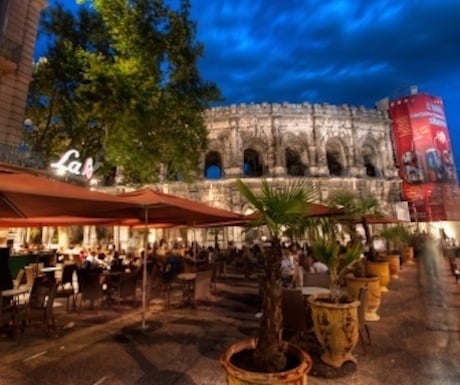 Arènes de Nîmes
During the 1st century AD, the Romans brought their passion for games and spectacles to the Gallic colony, building a grand amphitheatre in the city. Although not the largest example of Roman amphitheatre, the Arènes de Nîmes measures a total of 133 metres in length, 101 in width and 21 in height, fitting around 24,000 people. Considered to be one of the best preserved amphitheatres, the arena is a fine demonstration of the quality of Roman architecture and engineering. The exterior boasts a two-level facade of arches – an impressive 120 altogether – as well as sculptural decorations such as bulls and the mythological founders of Rome, Romulus and Remus. The true architectural genius lies within the amphitheatre walls, with the remnants of practical features like trap doors and a lift system for the ‘performers’. The arena could also be covered by a huge canopy attached to poles to ensure that baking sun or torrential rain did not hinder the games or the enjoyment of the crowd. In 1863, the amphitheatre was adapted to serve as a bullring and today hosts the Feria de Nîmes.
Arènes de Nîmes
During the 1st century AD, the Romans brought their passion for games and spectacles to the Gallic colony, building a grand amphitheatre in the city. Although not the largest example of Roman amphitheatre, the Arènes de Nîmes measures a total of 133 metres in length, 101 in width and 21 in height, fitting around 24,000 people. Considered to be one of the best preserved amphitheatres, the arena is a fine demonstration of the quality of Roman architecture and engineering. The exterior boasts a two-level facade of arches – an impressive 120 altogether – as well as sculptural decorations such as bulls and the mythological founders of Rome, Romulus and Remus. The true architectural genius lies within the amphitheatre walls, with the remnants of practical features like trap doors and a lift system for the ‘performers’. The arena could also be covered by a huge canopy attached to poles to ensure that baking sun or torrential rain did not hinder the games or the enjoyment of the crowd. In 1863, the amphitheatre was adapted to serve as a bullring and today hosts the Feria de Nîmes.
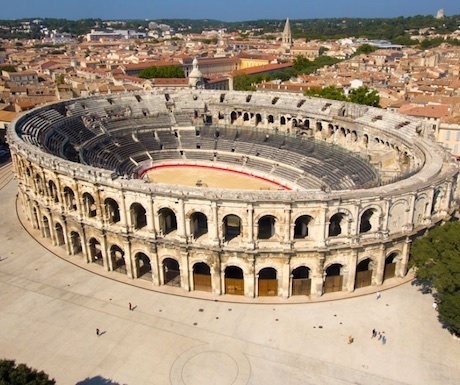 La Maison Carrée
Just before the end of the 1st century BC, the magnificent Temple of Mars Ultor was consecrated by the Emperor Augustus in Rome. The monumental architecture of this temple was emulated in other designs, including the Maison Carrée in Nîmes. Inspired by the ideas of the great architect, Vitruvius, the temple was dedicated to Augustus’ grandsons and intended heirs, Gaius and Lucius, who both died tragically in their youth. The temple facade is one of the best preserved in the world, demonstrating some typical features of monumental Roman architecture. The pediment of the temple is supported by six Corinthian columns – the most elaborate of the three classical orders – whilst the continuous exterior frieze is carved with an intricate acanthus leaf design. The preservation of the temple is thanks to its continuous use over the last 2,000 years, becoming a government building, church and museum at various points. After numerous stages of restoration since the 1800s, the Maison Carrée has finally recaptured its former glory.
La Maison Carrée
Just before the end of the 1st century BC, the magnificent Temple of Mars Ultor was consecrated by the Emperor Augustus in Rome. The monumental architecture of this temple was emulated in other designs, including the Maison Carrée in Nîmes. Inspired by the ideas of the great architect, Vitruvius, the temple was dedicated to Augustus’ grandsons and intended heirs, Gaius and Lucius, who both died tragically in their youth. The temple facade is one of the best preserved in the world, demonstrating some typical features of monumental Roman architecture. The pediment of the temple is supported by six Corinthian columns – the most elaborate of the three classical orders – whilst the continuous exterior frieze is carved with an intricate acanthus leaf design. The preservation of the temple is thanks to its continuous use over the last 2,000 years, becoming a government building, church and museum at various points. After numerous stages of restoration since the 1800s, the Maison Carrée has finally recaptured its former glory.
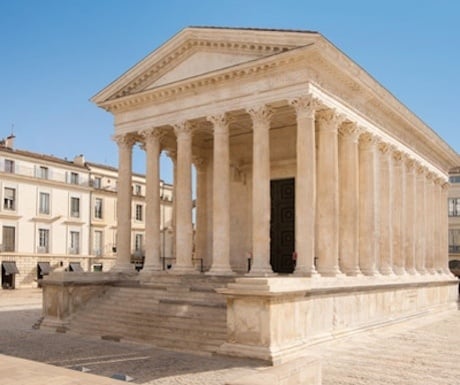 Carré d’Art
Next to the Maison Carrée sits the Carré d’Art – a large glass cube marked with neat lines and sunk partially below the ground. The building was designed by British architect, Norman Foster, and opened in 1993 as part of rejuvenation programme for the temple. The modern architecture continues to juxtapose the facing ancient structure inside, housing a 480-item collection of contemporary art from the 1960s to today. This collection was started in 1986, including photographs, paintings, graphics, sculptures and letters from French and international artists. Alongside its permanent collection, the museum also hosts a number of temporary exhibitions throughout the year, spotlighting both individuals and groups of artists. From October, the Carré d’Art is presenting the exhibition ‘Supports/Surfaces: the Beginning, 1966-1970’, looking at the French art movement during this brief period.
Carré d’Art
Next to the Maison Carrée sits the Carré d’Art – a large glass cube marked with neat lines and sunk partially below the ground. The building was designed by British architect, Norman Foster, and opened in 1993 as part of rejuvenation programme for the temple. The modern architecture continues to juxtapose the facing ancient structure inside, housing a 480-item collection of contemporary art from the 1960s to today. This collection was started in 1986, including photographs, paintings, graphics, sculptures and letters from French and international artists. Alongside its permanent collection, the museum also hosts a number of temporary exhibitions throughout the year, spotlighting both individuals and groups of artists. From October, the Carré d’Art is presenting the exhibition ‘Supports/Surfaces: the Beginning, 1966-1970’, looking at the French art movement during this brief period.
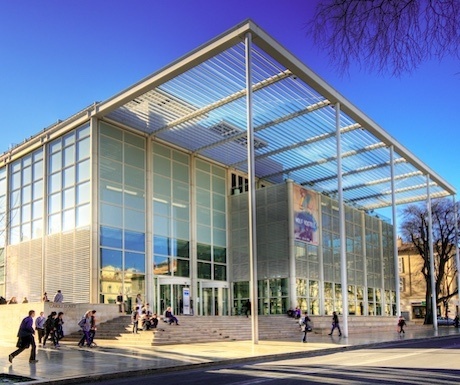 Musée des Beaux Arts
In 1821, the Maison Carrée became the home of various Roman artefacts, as well as a number of fine paintings from the contemporary period and past eras. During the early 20th century, a neoclassical building was designed by architect Max Raphel, becoming the new, larger location for the collection. The Musée des Beaux Arts today holds almost 4,000 works from throughout the ages, made up from private collections and donations. Perhaps one of the most striking pieces of the collection is the 50 square metre Roman floor mosaic of the ‘Marriage of Admetus’, dating to the late 2nd century AD. Across the museum, Old Master paintings from Flemish, Italian and French artists can be found; a highlight not to be missed is Paul Delaroche’s historic ‘Oliver Cromwell with the corpse of Charles I’. Until the end of the year, the Musée des Beaux Arts will be exhibiting various examples of decorative art, from vases produced by the notable Sèvres porcelain factory to the Art Deco glassworks of Marinot.
Musée des Beaux Arts
In 1821, the Maison Carrée became the home of various Roman artefacts, as well as a number of fine paintings from the contemporary period and past eras. During the early 20th century, a neoclassical building was designed by architect Max Raphel, becoming the new, larger location for the collection. The Musée des Beaux Arts today holds almost 4,000 works from throughout the ages, made up from private collections and donations. Perhaps one of the most striking pieces of the collection is the 50 square metre Roman floor mosaic of the ‘Marriage of Admetus’, dating to the late 2nd century AD. Across the museum, Old Master paintings from Flemish, Italian and French artists can be found; a highlight not to be missed is Paul Delaroche’s historic ‘Oliver Cromwell with the corpse of Charles I’. Until the end of the year, the Musée des Beaux Arts will be exhibiting various examples of decorative art, from vases produced by the notable Sèvres porcelain factory to the Art Deco glassworks of Marinot.
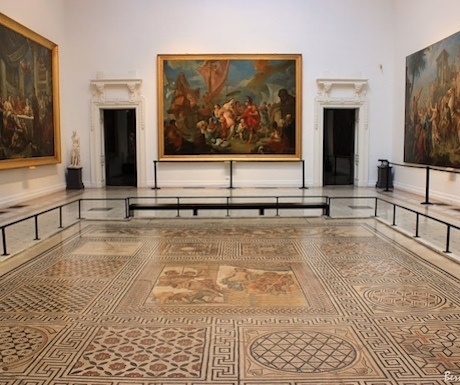 Pont du Gard
Under Roman rule, the Pont du Gard aqueduct was crucial to Nîmes, bringing water across a 50 kilometre route to the heart of the colony. Despite falling into disuse over the years, later restoration transformed the aqueduct into one of the most popular tourist attractions in France. The Pont du Gard is yet another well-preserved example of Roman architecture and engineering, combining functionality and aesthetic design. Standing almost 50 metres high across the Gardon River, the Pont du Gard is the highest elevated Roman aqueduct, earning it the status as a UNESCO World Heritage Site. The aqueduct consists of three levels of arches in decreasing sizes, with the smallest at the top. It is thought that the impressive structure was built from over 50,000 tons of limestone from a local quarry, demonstrating the Roman custom of locally sourcing building materials. The Pont du Gard is thought to be the brainchild of one of the most important figures in Roman history, Marcus Agrippa, who was the right-hand man of the Emperor Augustus during his early reign.
Pont du Gard
Under Roman rule, the Pont du Gard aqueduct was crucial to Nîmes, bringing water across a 50 kilometre route to the heart of the colony. Despite falling into disuse over the years, later restoration transformed the aqueduct into one of the most popular tourist attractions in France. The Pont du Gard is yet another well-preserved example of Roman architecture and engineering, combining functionality and aesthetic design. Standing almost 50 metres high across the Gardon River, the Pont du Gard is the highest elevated Roman aqueduct, earning it the status as a UNESCO World Heritage Site. The aqueduct consists of three levels of arches in decreasing sizes, with the smallest at the top. It is thought that the impressive structure was built from over 50,000 tons of limestone from a local quarry, demonstrating the Roman custom of locally sourcing building materials. The Pont du Gard is thought to be the brainchild of one of the most important figures in Roman history, Marcus Agrippa, who was the right-hand man of the Emperor Augustus during his early reign.
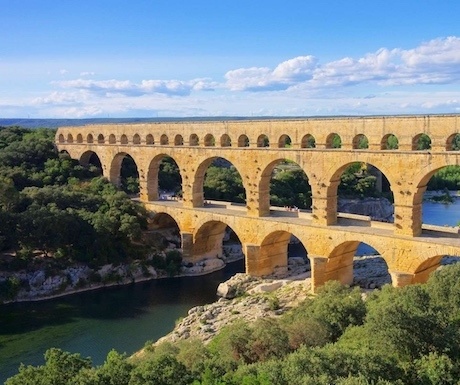
Did you enjoy this article?
Receive similar content direct to your inbox.


I did not know there was such a large Roman amphitheatre in Nimes, in fact I did not know there was one this large outside of Italy. It looks very impressive, and as an architectural fan I would love to visit.
Thanks for always making me aware of so many beautiful places that I have never heard of before. ‘French Rome’ sounds super interesting. The arena looks impressive, definitely like a film set or something. And the Pont du Gard looks like an ideal photography spot, would love to bring my tripod and camera there!!